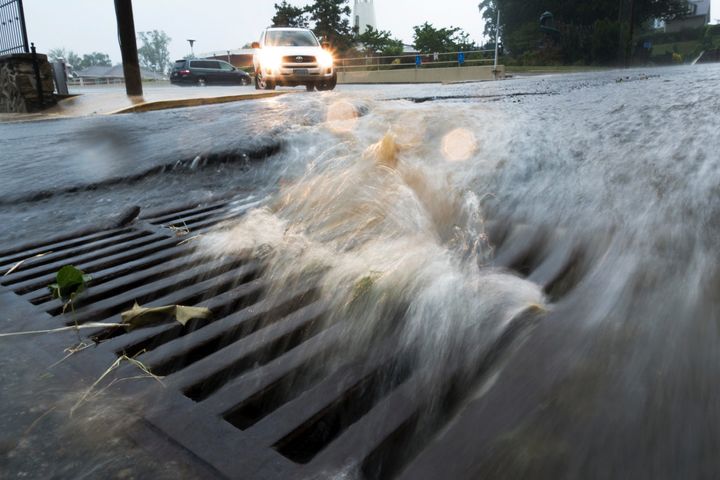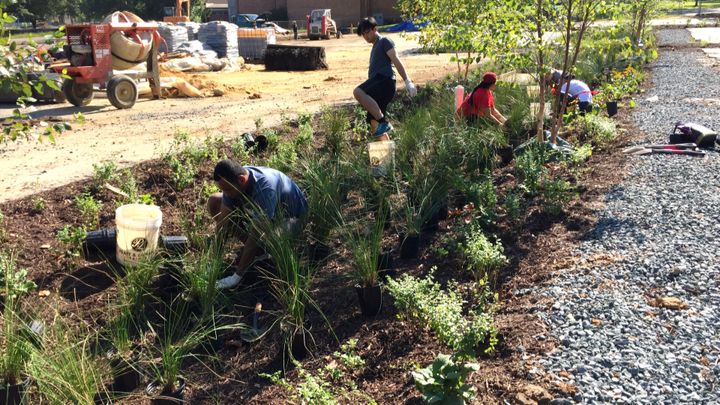
Stormwater runoff in Arlington, Virginia.
America has a big infrastructure problem. More precisely, it has a $3.6 trillion problem. That's what it will take to fix the country's aging roads, bridges, levees, water mains and other systems that sustain our communities and economy, according to the American Society of Civil Engineers.
When you think of rebuilding America's infrastructure, bioswales, artificial wetlands and coral reefs probably don't spring to mind. But they should.
These projects may not be as flashy as a massive new seawall or state-of the-art water treatment plant. But "green infrastructure" solutions can often provide the same services as traditional manmade structures and often do so at less cost. Plus, they provide great environmental benefits at no extra cost.
Solving stormwater
Around the world, cities are turning to nature to address a serious environmental and public health problem — stormwater runoff.
Stormwater is the fastest growing source of freshwater pollution in the world. Take my hometown of Washington, D.C. During intense rainstorms — which are happening more and more often — water rushes over paved surfaces, picking up trash, oil, pesticides and other pollutants that flush into storm-drain systems. Each year, 3 billion gallons of polluted water flows into the Potomac and Anacostia Rivers, eventually making its way to the Chesapeake Bay.
Even worse, when stormwater and sewer systems are combined, as they are in many U.S. cities, big storms can cause overflows that send raw sewage into nearby waterways.
Hundreds of cities around the country are struggling to meet federally-mandated water quality goals designed to address this kind of pollution. While billions of dollars will be spent on traditional “gray” solutions, rain gardens, bioswales, restored wetlands and other forms of green infrastructure can soak up stormwater runoff and slow water down before it reaches overburdened sewer systems. These solutions are not only cost effective but also provide co-benefits in the form of urban green space, improved air quality and community development.

Planting a rain garden in a church parking lot as part of D.C.’s stormwater runoff project.
Investing in nature
So, how can cities accelerate their use of green infrastructure to manage stormwater runoff?
It all starts with forward-thinking municipal policies.
Like many cities, Washington, D.C., now mandates that developers retain stormwater runoff from their properties. But D.C.'s regulation is unique. It allows developers to use offsite, green infrastructure solutions. Developers can meet up to half of their stormwater retention requirements by buying credits from retention projects built across the city. Right now, D.C. is the only city that allows developers to do this.
This system has created a unique opportunity for private investment in nature. Using impact capital from Prudential Financial, TNC's impact investing unit, NatureVest, and partner Encourage Capital created a local company that is financing and developing green infrastructure projects in areas of D.C. that could most benefit from additional green space. Those projects generate credits that developers can purchase to meet their stormwater retention requirements. Credit sales will generate returns for investors.
A Triple Win
D.C's stormwater retention market is a great example of a triple win. Green infrastructure:
- Protects nature. Polluted runoff is captured before reaching local waterways, improving water quality and wildlife habitat in the Anacostia and Potomac Rivers and the Chesapeake Bay.
- Boosts the economy. Green infrastructure investments can ease fiscal pressures on tight government budgets and lower residents' water bills. They save developers money, since onsite solutions like green roofs and cisterns can often be more expensive and reduce the amount of space for desirable amenities such as parking spots, pools or other roof space. And through the sale of retention credits, they create returns for impact investors.
- Benefits communities. Green infrastructure projects create green space in neighborhoods, reduce flood risk and create jobs to build and maintain the installations.
So what's next?
America's water infrastructure is in desperate need of fixing, and the job is too big for the public sector alone.
So what can we do to make solutions like D.C.'s available to other cities? City leaders, for one, can look for more ways to invest in green infrastructure. Developers can push local governments to allow for offsite stormwater retention credits. And investors can help create bigger markets by seeking out opportunities to fund nature-based solutions.
With billions of dollars expected to be invested in traditional infrastructure in coming years, diverting a substantial portion of these funds toward green infrastructure solutions would be a win-win. Nature can help meet the infrastructure needs of America's cities while also delivering a range of other benefits, all at a lower cost than traditional solutions. We will need to be creative in order to meet the country's infrastructure challenges. Solutions like D.C.'s stormwater market can help lead the way.
*This article originally appeared on October 23, 2017 in Forbes.
Mark Tercek is the president and CEO of the Nature Conservancy and author of Nature’s Fortune. Follow Mark on Twitter: @MarkTercek.
